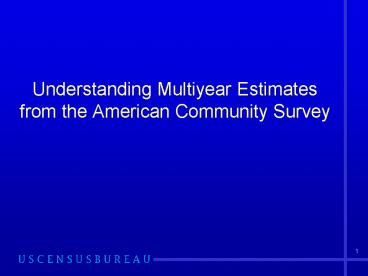Understanding Multiyear Estimates from the American Community Survey - PowerPoint PPT Presentation
1 / 34
Title:
Understanding Multiyear Estimates from the American Community Survey
Description:
An estimate that describes the average characteristics of an area over a specific time period ... Period for ACS 1-year estimates is the calendar year ... – PowerPoint PPT presentation
Number of Views:52
Avg rating:3.0/5.0
Title: Understanding Multiyear Estimates from the American Community Survey
1
Understanding Multiyear Estimates from the
American Community Survey
2
Overview
- What are multiyear estimates?
- When should you use multiyear estimates?
- What should you be aware of when using multiyear
estimates? - How can you use multiyear estimates to make
comparisons? - Example of using multiyear estimates
3
What are multiyear estimates?
4
What is a Period Estimate?
- Definition
- An estimate that describes the average
characteristics of an area over a specific time
period - Period for ACS 1-year estimates is the calendar
year - Different from a point-in-time estimate
5
What is a Multiyear Estimate?
- Definition
- A period estimate that encompasses more than one
calendar year - Period for ACS multiyear estimates is either 3
or 5 calendar years
6
Population Thresholds for ACS Estimates
7
How to Label Multiyear Estimates
- ACS estimates based on data collected from
2005-2007 should not be labeled 2006 or 2007
estimates - Multiyear estimates do not represent any one year
or the midpoint of a period - Correct labeling for multiyear estimate The
child poverty rate for the 2005-2007 period was X
percent.
8
Constructing Multiyear Estimates
- Data are pooled across 36 or 60 months
- Data are weighted to produce estimates
- Estimates are controlled for age, sex, race, and
Hispanic origin - Multiyear estimates are not an average of 1-year
estimates
9
When should I use multiyear estimates?
10
Use Multiyear Estimates When
- No 1-year estimate is available
- Margins of error for 1-year estimates are larger
than required - Analyzing data for small population groups
11
Currency vs. Reliability
12
Reliability
Note Fictional data
13
What should I be aware of when using multiyear
estimates?
14
Inflation Adjustment
- Dollar-valued data items are inflation adjusted
to the most recent year for the period - Income, rent, home value, and energy costs
- Adjusted using inflation factors based on the
Consumer Price Index (CPI) - Adjustment designed to put the data into dollars
with equal purchasing power
15
Geographic Boundaries
- Multiyear estimates are based on geographic
boundaries as of January 1 of the last year in
the multiyear period - Boundary Annexation Survey collects boundary
changes - Boundaries of other statistical areas will be
updated every decade in conjunction with the
decennial census
16
Geographic Boundaries Amarillo city, Texas
17
Population Controls
- Estimates of housing units and people are
controlled to the population estimates derived
from the Population Estimates Program - Multiyear estimates are controlled to the average
of the individual years estimates for the period
18
How can I use multiyear estimates to make
comparisons?
19
Comparing Across Geographies
- Only compare the same type of estimate
- 1-year estimates to other 1-year estimates
- 3-year estimates to other 3-year estimates
- 5-year estimates to other 5-year estimates
- Same time period
20
Counties in Kentucky, by Population Size
Source U.S. Census Bureau, American Community
Survey Handbook for General Audiences.
21
Comparing Data in 2010
22
Comparing Across Time Periods
- Same geographic area
- Use caution if geographic boundaries have changed
over time - Easier to compare non-overlapping periods
- Make comparisons using the same length time period
23
Overlapping Periods
24
Comparing ACS Data with Census 2000
- Global differences exist between ACS and Census
2000 - Comparisons can be made for most population and
housing subjects - http//www.census.gov/acs/www/UseData/compACS.htm
25
Example of using multiyear estimates
26
Tracking Social Change
- 7 school districts in the county of Centerville,
USA - Question to be answered
- Has there been a change in the population with a
high school diploma in these school districts?
27
Determining Which Data To Use
- Since the data must be current, decennial
census long form data for 1990 and 2000 are not
adequate - A data analyst turns to the ACS data for a look
at trends since 2000 - Only data available are three-year ACS estimates
for 7 school districts
28
Centerville County, USA
29
3-Year Estimates Available for the School
Districts, 1999-2005
30
Choosing the Estimates
These estimates allow for ten comparisons
- 1999-2001 vs. 2000-2002
- 1999-2001 vs. 2001-2003
- 1999-2001 vs. 2002-2004
- 1999-2001 vs. 2003-2005
- 2000-2002 vs. 2001-2003
- 2000-2002 vs. 2002-2004
- 2000-2002 vs. 2003-2005
- 2001-2003 vs. 2002-2004
- 2001-2003 vs. 2003-2005
- 2002-2004 vs. 2003-2005
31
Determining Which Estimates to Use
32
Summary What Have We Learned?
- Multiyear estimates are period estimates
- Multiyear estimates should be interpreted and
labeled as period estimates - Data users should consider the tradeoffs of
currency versus reliability
33
Summary What Have We Learned?
- Comparisons between estimates of different
geographies should be based on ACS data from the
same time periods - It is easier to compare estimates from
non-overlapping periods
34
For more information
- Subscribe to ACS Alert
- http//www.census.gov/acs/www/Special/Alerts.htm
- Visit the ACS/PRCS website
- http//www.census.gov/acs/www
- Contact by telephone
- 1-800-923-8282
- Contact by email
- acso.users.support_at_census.gov
34
34































